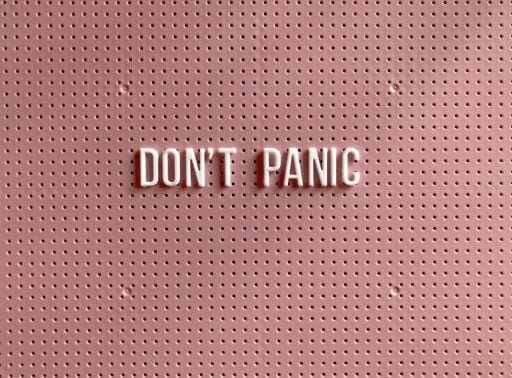Imagine feeling an overwhelming surge of fear, your heart pounding, your breath becoming shallow, as if the world around you is closing in. Panic attacks can be debilitating, leaving you feeling helpless and disconnected from reality. But fear not, for there are effective strategies to ease the grip of panic attacks and regain control of your life. In this article, we will explore practical techniques and coping mechanisms that can help you navigate the storm of anxiety and find solace in serenity. So take a deep breath, find a comfortable seat, and let us guide you on a journey towards a calmer, more balanced existence.
Understanding Panic Attacks
Definition of panic attacks
Panic attacks are intense periods of distress or fear characterized by sudden and overwhelming feelings of terror. During a panic attack, you may experience a combination of physical and emotional symptoms that can be incredibly disruptive and overwhelming. These episodes typically reach their peak within minutes and can leave an individual feeling exhausted and emotionally drained.
Causes of panic attacks
The exact cause of panic attacks is not fully understood, but various factors may contribute to their onset. One of the main underlying factors is believed to be an imbalance of neurotransmitters in the brain, such as serotonin and norepinephrine. Additionally, genetics, stress, trauma, and certain medical conditions, such as thyroid problems or heart disease, may also increase the risk of experiencing panic attacks.
Symptoms of panic attacks
Panic attacks can manifest in a variety of ways, with symptoms varying from person to person. Some common physical symptoms include a rapid heart rate, chest pain or tightness, dizziness, shortness of breath, trembling, sweating, and a sensation of choking or being smothered. Individuals may also experience intense feelings of fear, impending doom, or a loss of control. It is important to note that panic attacks can be highly distressing, and seeking professional help is crucial in managing and overcoming these episodes.
Seeking Professional Help
Importance of seeking professional help
Seeking professional help is vital when dealing with panic attacks. A trained professional can help to accurately diagnose panic disorder and identify the factors contributing to your symptoms. They can provide guidance, support, and effective treatment options tailored to your specific needs. By seeking assistance, you can gain a better understanding of your condition, reduce the frequency and severity of panic attacks, and learn valuable coping mechanisms to regain control of your life.
Types of professionals to consult
There are several types of professionals you can consult when seeking help for panic attacks. Psychiatrists are medical doctors who specialize in mental health and can prescribe medication if necessary. Psychologists, on the other hand, provide therapy and counseling services to help address underlying issues contributing to panic attacks. Additionally, licensed therapists, such as clinical social workers or psychiatric nurse practitioners, can offer support and guidance through therapy sessions.
Therapy options
Therapy plays a fundamental role in helping individuals manage and overcome panic attacks. Cognitive Behavioral Therapy (CBT) is a widely recognized and effective approach that focuses on identifying and challenging negative thought patterns and behaviors. Exposure Therapy is another type of therapy that gradually exposes individuals to their fears or triggers in a safe and controlled environment. Both approaches can help individuals develop effective coping strategies and alleviate panic attack symptoms.

Lifestyle Changes
Manage stress levels
Stress can significantly contribute to the frequency and intensity of panic attacks. By managing stress levels, you can reduce the likelihood of experiencing panic attacks. Practice stress management techniques such as meditation, deep breathing exercises, journaling, or engaging in hobbies that bring you joy. Additionally, ensure that you have a healthy work-life balance, set realistic expectations, and prioritize self-care to minimize stress in your daily life.
Regulate sleep patterns
The quality and quantity of your sleep can impact your overall mental well-being and potentially trigger panic attacks. Establish a regular sleep routine by going to bed and waking up at consistent times. Create a sleep-friendly environment by keeping your bedroom cool, dark, and comfortable. Avoid stimulating activities or electronics before bed, and consider incorporating relaxation techniques, such as meditation or reading a book, to help you unwind and prepare for a good night’s sleep.
Maintain a balanced diet
The foods you consume can have a significant impact on your mental and physical health. Aim to maintain a balanced diet that includes a variety of nutrient-rich foods, such as fruits, vegetables, whole grains, lean proteins, and healthy fats. Avoid or limit the intake of caffeine, sugary foods, and processed snacks, as these can potentially trigger or worsen anxiety symptoms. Stay hydrated by drinking an adequate amount of water throughout the day to support your overall well-being.
Incorporate regular exercise
Regular physical activity has been shown to have numerous benefits for mental health, including reducing anxiety and stress levels. Engage in exercises that you enjoy, such as walking, cycling, swimming, or yoga. Aim for at least 150 minutes of moderate-intensity aerobic activity or 75 minutes of vigorous-intensity aerobic activity per week. By incorporating regular exercise into your routine, you can promote a sense of well-being, improve sleep quality, and help manage panic attacks more effectively.
Deep Breathing Exercises
Diaphragmatic breathing
Diaphragmatic breathing, also known as belly breathing, is a relaxation technique that involves deep inhalation and exhalation from the diaphragm. To practice diaphragmatic breathing, sit or lie in a comfortable position. Place one hand on your chest and the other on your abdomen. Breathe in deeply through your nose, allowing your abdomen to rise as you fill your lungs with air. Slowly exhale through your mouth, feeling your abdomen lower. Repeat this process for several minutes, focusing on the sensation of your breath and allowing yourself to relax.
4-7-8 breathing technique
The 4-7-8 breathing technique is a simple yet effective method for reducing anxiety and promoting relaxation. Begin by sitting in a comfortable position and close your eyes. Take a deep breath through your nose for a count of four. Hold the breath for a count of seven. Finally, exhale slowly through your mouth for a count of eight. Repeat this cycle for a few minutes, allowing your breath to become slower and more rhythmic with each repetition. The 4-7-8 breathing technique can help calm your nervous system and alleviate panic attack symptoms.
Box breathing
Box breathing, also known as square breathing, is a technique that focuses on equalizing the duration of your inhalation, holding, exhalation, and resting phases of the breath. Start by inhaling slowly through your nose for a count of four. Hold your breath for a count of four. Exhale slowly through your mouth for a count of four. Finally, hold your breath for a count of four before starting the cycle again. Repeat this pattern for several minutes, allowing yourself to find a sense of calm and relaxation.
Progressive muscle relaxation
Progressive muscle relaxation is a technique that involves systematically tensing and then releasing different muscle groups in your body to promote relaxation. Start by finding a comfortable position and take a few deep breaths to center yourself. Begin with your toes, tensing the muscles for a few seconds, and then gradually release the tension as you exhale. Move slowly up through your body, tensing and releasing each muscle group, such as your legs, abdomen, chest, arms, and face. Focus on the sensations of tension and relaxation in each muscle group, allowing yourself to unwind and let go of tension.

Practicing Mindfulness and Meditation
Mindfulness techniques
Mindfulness involves bringing your attention to the present moment without judgment. It can help interrupt the cycle of anxious thoughts and bring a sense of calm. To practice mindfulness, find a quiet space and sit in a comfortable position. Focus on your breath, noticing the sensation of air entering and leaving your body. If your mind starts to wander, gently bring your attention back to your breath. You can also incorporate mindfulness into everyday activities, such as eating, walking, or even doing household chores, by paying attention to the present moment and fully engaging your senses.
Meditation practices
Meditation offers a range of techniques to calm the mind and promote relaxation. There are various types of meditation, including guided meditation, mantra meditation, loving-kindness meditation, and body scan meditation. Find a meditation technique that resonates with you and allocate a specific time each day to practice. Start with just a few minutes and gradually increase the duration as you become more comfortable. Through regular meditation practice, you can cultivate a greater sense of self-awareness, reduce anxiety, and enhance your overall well-being.
Cognitive Behavioral Therapy (CBT)
Identifying and challenging negative thoughts
Cognitive Behavioral Therapy (CBT) is a highly effective therapeutic approach for managing panic attacks. It focuses on identifying and challenging negative thought patterns that contribute to anxiety and panic. By working with a therapist, you can learn to recognize and replace irrational thoughts with more balanced and realistic ones. This process helps to reduce the intensity and frequency of panic attacks, empowering you to regain control over your thoughts and emotions.
Developing coping mechanisms
CBT also helps individuals develop effective coping mechanisms to manage panic attacks. Through therapy sessions, you can learn various strategies such as relaxation techniques, behavior modification, and problem-solving skills. These tools and techniques can be invaluable in preventing panic attacks or minimizing their impact when they occur. CBT equips you with practical skills to overcome panic attacks and build resilience in the face of anxiety-provoking situations.
Examining underlying causes
In addition to addressing the immediate symptoms of panic attacks, CBT delves into the underlying causes and contributing factors. By exploring past experiences, beliefs, and patterns of behavior, CBT can help uncover and address the root causes of your panic attacks. Understanding these underlying factors can provide insight and pave the way for lasting change and a reduction in panic attack frequency and intensity.

Utilizing Relaxation Techniques
Progressive muscle relaxation
Progressive muscle relaxation involves systematically tensing and releasing different muscle groups in your body to promote deep relaxation. By intentionally tensing and then releasing each muscle group, you can become more attuned to your body and facilitate a sense of calm and relaxation. With regular practice, progressive muscle relaxation can help reduce muscle tension, ease stress, and lower anxiety levels.
Guided imagery
Guided imagery is a relaxation technique that involves mentally visualizing peaceful and calming images. Find a quiet and comfortable space, and close your eyes. Choose a relaxing scene or location in your mind, such as a beach, garden, or peaceful forest. Imagine yourself in that place, picturing the colors, sounds, and sensations associated with it. Engaging in guided imagery can help shift your focus away from anxious thoughts and promote relaxation and tranquility.
Aromatherapy
Aromatherapy utilizes the therapeutic properties of essential oils to promote relaxation and reduce anxiety. Lavender, chamomile, bergamot, jasmine, and ylang-ylang are among the essential oils commonly used for their calming effects. You can incorporate aromatherapy by using essential oil diffusers, adding a few drops to a warm bath, or trying out calming scented candles. Experiment with different scents to find the one that resonates with you and helps create a soothing environment.
Music therapy
Music has a profound impact on mood and can be a powerful tool for relaxation. Create a playlist of calming and soothing music that you enjoy and find relaxing. Take a few moments each day to listen to this playlist, allowing yourself to fully immerse in the melodies and rhythms. You can also explore guided meditation audio tracks or nature sounds to enhance your relaxation experience. Music therapy offers a therapeutic avenue to unwind, reduce anxiety, and ease the symptoms of panic attacks.
Maintaining a Support System
Enlisting the support of friends and family
Maintaining a strong support system is essential when managing panic attacks. Reach out to your friends and family members and let them know about your struggles and the support you need. Surrounding yourself with understanding and empathetic individuals can provide a sense of comfort and reassurance. Sharing your experiences with loved ones not only helps you feel less alone but also allows them to offer encouragement and assistance when needed.
Joining support groups
Support groups can be a valuable resource for individuals dealing with panic attacks. Connecting with others who have similar experiences can provide a sense of belonging and understanding. These groups provide a safe space to share concerns, exchange coping strategies, and gain insights from others who have successfully managed their panic attacks. Seek out local support groups or online communities dedicated to anxiety and panic disorders to find support and encouragement.
Participating in online forums
Online forums and communities can provide a wealth of knowledge and support for individuals struggling with panic attacks. Engage in discussions, ask questions, and share your experiences. Connecting with others who understand your challenges can offer a unique perspective and valuable advice. Remember to exercise caution and choose reputable online platforms that prioritize empathy, respect, and evidence-based information.
Avoiding Triggers
Identifying personal triggers
Identifying personal triggers is crucial in managing panic attacks. Take the time to reflect on the circumstances that often precede or exacerbate your panic attacks. Common triggers may include certain situations, places, people, or even specific thoughts or memories. Keep a journal to track your panic attacks and note any patterns or commonalities. By understanding your triggers, you can take proactive steps to avoid or reduce their impact on your well-being.
Making necessary lifestyle changes
Once you have identified your triggers, it may be necessary to make lifestyle changes to minimize their impact. For example, if crowded places trigger your panic attacks, you may need to adjust your daily routine to avoid those situations or practice relaxation techniques before entering such environments. By modifying your lifestyle to reduce exposure to triggers, you can create a more supportive and conducive environment for managing panic attacks.
Creating a safe environment
Creating a safe environment within your home can contribute significantly to managing panic attacks. Designate a space or corner in your living space that you find calming and secure. Fill this area with items that bring you comfort and peace, such as soft blankets, scented candles, or calming artwork. This safe haven can serve as a retreat during times of stress and anxiety, allowing you to find solace and regain a sense of control.
Self-Care Practices
Prioritizing self-care
Prioritizing self-care is crucial in managing and reducing panic attacks. Set aside dedicated time each day to engage in activities that recharge and relax you. This may include taking a warm bath, reading a book, practicing a hobby, or simply enjoying quiet alone time. Remember that self-care is not indulgent or selfish; it is a necessary aspect of maintaining your mental and emotional well-being.
Engaging in hobbies and activities
Engaging in hobbies and activities that bring you joy and fulfillment can be an effective way to distract yourself from anxious thoughts and reduce the frequency of panic attacks. Identify activities that you love and make an effort to include them in your routine regularly. Whether it’s painting, playing a musical instrument, gardening, or hiking, immersing yourself in activities that bring you happiness can have a profound impact on your overall mental well-being.
Taking breaks and practicing self-compassion
In the midst of managing panic attacks, it is essential to remember to take regular breaks and practice self-compassion. Recognize when you need rest and allow yourself the time and space to recharge. Be kind and understanding towards yourself, acknowledging that you are doing your best in challenging circumstances. Practicing self-compassion can help reduce the pressure and self-criticism, allowing for a gentler and more supportive approach towards managing panic attacks.